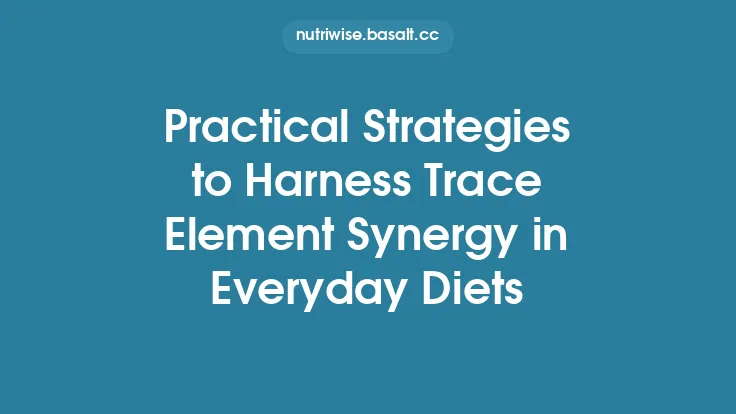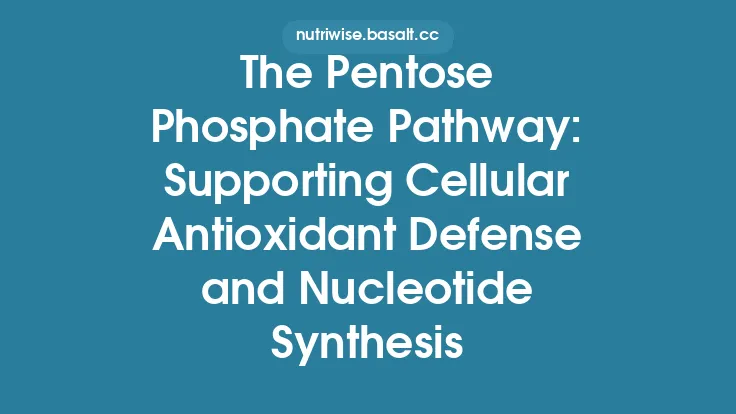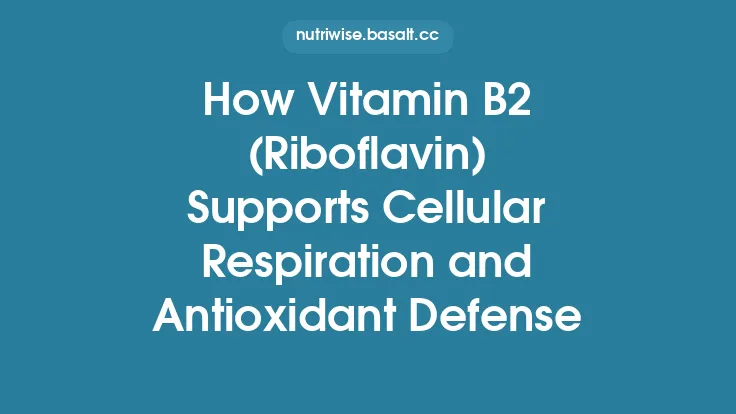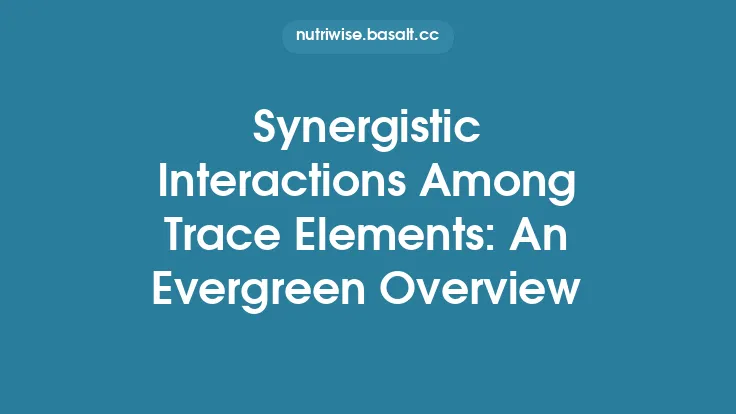Antioxidant defense is a finely tuned orchestra of enzymes, small molecules, and trace elements that work together to keep oxidative stress in check. While many people recognize the role of vitamins such as C and E in neutralizing free radicals, the contribution of trace elements—minerals required in minute amounts—often goes unnoticed. Certain pairings of these micronutrients create a synergistic environment where each element amplifies the protective actions of the other, leading to a more robust and resilient antioxidant system. Below, we explore the most compelling trace‑element duos that specifically bolster the body’s ability to scavenge reactive oxygen species (ROS), repair oxidative damage, and maintain cellular health.
The Core Antioxidant Enzyme Systems and Their Trace Element Requirements
Before diving into specific pairings, it helps to understand the primary antioxidant enzymes that depend on trace elements for activity:
| Enzyme | Primary Trace Element(s) | Main Function |
|---|---|---|
| Cu/Zn‑Superoxide Dismutase (SOD1) | Copper (Cu) & Zinc (Zn) | Converts superoxide (O₂⁻) → hydrogen peroxide (H₂O₂) |
| Mn‑Superoxide Dismutase (SOD2) | Manganese (Mn) | Same reaction as SOD1, but located in mitochondria |
| Catalase | Iron (Fe) (heme‑containing) | Decomposes H₂O₂ → water + O₂ |
| Glutathione Peroxidase (GPx) | Selenium (Se) (as selenocysteine) | Reduces lipid hydroperoxides & H₂O₂ using glutathione (GSH) |
| Thioredoxin Reductase | Selenium (Se) | Regenerates reduced thioredoxin, a key protein‑based antioxidant |
| Peroxiredoxins | Iron (in some isoforms) & Selenium (in others) | Reduce peroxides, often working with thioredoxin |
Each enzyme operates best when its required trace element is present in adequate amounts. However, the enzymes do not act in isolation; the product of one reaction (e.g., H₂O₂ from SOD) becomes the substrate for another (e.g., GPx or catalase). This interdependence creates natural opportunities for synergistic pairings.
Selenium and Manganese – A Dual Front Against Reactive Oxygen Species
Why the pairing matters
Selenium is the cornerstone of the glutathione peroxidase family, while manganese fuels mitochondrial SOD2. Together, they form a two‑step shield:
- Mn‑SOD rapidly converts the superoxide generated by the electron transport chain into H₂O₂.
- Se‑GPx then reduces that H₂O₂ to water, preventing the formation of the highly reactive hydroxyl radical (·OH) via the Fenton reaction.
Mechanistic synergy
- Spatial complementarity: Mn‑SOD resides inside mitochondria, the primary site of ROS production. Selenium‑dependent GPx isoforms (GPx1, GPx4) are also abundant in mitochondria, ensuring that H₂O₂ is detoxified before it can diffuse into the cytosol.
- Redox recycling: GPx uses reduced glutathione (GSH) as a co‑factor. Adequate manganese supports the activity of mitochondrial NADPH‑dependent enzymes (e.g., isocitrate dehydrogenase) that regenerate GSH via the glutathione reductase system, indirectly sustaining GPx function.
Evidence snapshot
- Animal studies show that combined supplementation of selenium (0.2 mg/kg) and manganese (30 mg/kg) reduces markers of lipid peroxidation (malondialdehyde) more effectively than either mineral alone.
- In human trials with older adults, a 12‑week regimen of selenium (100 µg/day) plus manganese (2 mg/day) improved erythrocyte GPx activity and lowered plasma superoxide levels.
Practical take‑away
Include foods rich in both minerals: Brazil nuts (Se), sunflower seeds (Mn), whole grains, legumes, and leafy greens. For those at risk of deficiency (e.g., elderly, vegans), a modest combined supplement can be considered under professional guidance.
Zinc and Selenium – Complementary Roles in Redox Homeostasis
Why the pairing matters
Zinc is a structural component of Cu/Zn‑SOD, stabilizing the enzyme and protecting it from oxidative inactivation. Selenium, as noted, drives GPx. The zinc‑selenium duo therefore bridges the cytosolic superoxide dismutation step with downstream peroxide removal.
Mechanistic synergy
- Enzyme protection: Zinc’s ability to bind sulfhydryl groups shields proteins from oxidation. By maintaining the integrity of GPx’s selenocysteine active site, zinc indirectly supports selenium’s antioxidant function.
- Metal‑induced oxidative stress mitigation: Excess free copper or iron can catalyze ROS formation. Zinc competes with these pro‑oxidant metals for binding sites, reducing their catalytic availability. This “metal‑buffering” effect lessens the burden on selenium‑dependent GPx.
Evidence snapshot
- A double‑blind study in smokers demonstrated that a supplement containing zinc (30 mg) and selenium (200 µg) reduced urinary 8‑hydroxy‑2′‑deoxyguanosine (a DNA oxidation marker) by 25 % compared with placebo.
- In vitro experiments with cultured hepatocytes showed that zinc pre‑treatment up‑regulated GPx mRNA expression, an effect amplified when selenium was simultaneously supplied.
Practical take‑away
Combine zinc‑rich foods (oysters, pumpkin seeds, beef) with selenium sources (Brazil nuts, fish, eggs). For individuals with high oxidative stress (e.g., chronic smokers, athletes), a balanced zinc‑selenium supplement may provide added protection, but dosage should respect the upper tolerable limits (40 mg Zn/day, 400 µg Se/day).
Copper and Manganese – Synergistic Support for Superoxide Dismutation and Peroxidase Activity
Why the pairing matters
Copper is essential for the cytosolic Cu/Zn‑SOD, while manganese fuels mitochondrial Mn‑SOD. When both enzymes operate efficiently, superoxide is cleared from both the cytosol and mitochondria, limiting the cascade of oxidative damage.
Mechanistic synergy
- Cross‑compartmental ROS control: Cytosolic Cu‑SOD handles superoxide generated by NADPH oxidases, whereas Mn‑SOD tackles mitochondrial leakage. Their combined activity reduces the overall superoxide load, decreasing the demand on downstream peroxidases (GPx, catalase).
- Copper‑dependent ceruloplasmin: This ferroxidase converts Fe²⁺ → Fe³⁺, limiting the Fe²⁺ available for the Fenton reaction. By curbing free iron, copper indirectly supports selenium‑GPx and iron‑catalase pathways.
Evidence snapshot
- In a rodent model of ischemia‑reperfusion injury, co‑administration of copper (2 mg/kg) and manganese (10 mg/kg) lowered myocardial infarct size by 30 % versus untreated controls, correlating with higher SOD activity in both compartments.
- Human observational data reveal that individuals with higher dietary copper and manganese intakes have lower plasma levels of 4‑hydroxynonenal, a lipid peroxidation product.
Practical take‑away
Balanced intake is key: excessive copper can be pro‑oxidant, while manganese excess may affect neurological health. Aim for dietary sources—shellfish, nuts, whole grains (copper) and nuts, legumes, whole grains (manganese)—and avoid high‑dose single‑mineral supplements unless medically indicated.
Iron and Selenium – Balancing Pro‑oxidant and Antioxidant Forces
Why the pairing matters
Iron is a double‑edged sword: it is indispensable for catalase and numerous metabolic enzymes, yet free iron catalyzes the Fenton reaction, generating the most damaging hydroxyl radical. Selenium‑dependent GPx can neutralize the H₂O₂ that would otherwise react with iron to produce ·OH, thus tempering iron’s pro‑oxidant potential.
Mechanistic synergy
- H₂O₂ “gatekeeper”: Catalase (Fe‑heme) rapidly decomposes high concentrations of H₂O₂, while GPx (Se) handles lower, steady‑state levels. Together they keep H₂O₂ below the threshold where iron‑mediated Fenton chemistry becomes problematic.
- Iron‑sulfur cluster protection: Selenium‑containing proteins (e.g., thioredoxin reductase) help maintain the reduced state of iron‑sulfur clusters in mitochondrial enzymes, preserving their function under oxidative stress.
Evidence snapshot
- A clinical trial in patients with iron‑deficiency anemia showed that adding selenium (200 µg/day) to standard iron therapy (ferrous sulfate 100 mg elemental Fe) reduced oxidative DNA damage markers by 18 % compared with iron alone.
- In vitro, cultured neuronal cells exposed to excess Fe²⁺ exhibited markedly less lipid peroxidation when co‑treated with selenite, indicating selenium’s protective buffering of iron‑driven ROS.
Practical take‑away
Combine iron‑rich foods (red meat, lentils, spinach) with selenium sources in the same meal to promote coordinated antioxidant action. For individuals with hemochromatosis or high iron stores, selenium supplementation may help mitigate iron‑induced oxidative stress, but should be monitored by a healthcare professional.
Chromium and Selenium – Modulating Oxidative Stress in Glucose Metabolism
Why the pairing matters
Chromium enhances insulin signaling, which indirectly influences oxidative stress: improved glucose uptake reduces hyperglycemia‑driven ROS production. Selenium, meanwhile, directly scavenges ROS. Their combined effect can be especially valuable for individuals with insulin resistance or pre‑diabetes.
Mechanistic synergy
- Insulin‑mediated ROS reduction: Adequate chromium (as trivalent chromium) improves the activity of the insulin receptor, decreasing chronic activation of NADPH oxidase that otherwise elevates superoxide.
- Se‑GPx cleanup: Any residual H₂O₂ generated during glucose metabolism is efficiently reduced by selenium‑dependent GPx, preventing downstream oxidative damage to vascular endothelium.
Evidence snapshot
- A 6‑month randomized trial in adults with impaired glucose tolerance reported that a supplement containing chromium picolinate (200 µg) plus selenium (100 µg) lowered fasting plasma glucose by 7 % and reduced plasma malondialdehyde by 22 % compared with placebo.
- Animal studies demonstrate that chromium deficiency amplifies oxidative stress markers, an effect that is markedly attenuated when selenium is concurrently supplied.
Practical take‑away
Whole‑food sources of chromium (broccoli, whole grains, nuts) paired with selenium‑rich foods (fish, Brazil nuts) can be incorporated into meals that support both glycemic control and antioxidant capacity. Supplementation should respect the tolerable upper intake level for chromium (1 mg/day) and selenium (400 µg/day).
Emerging Pairings: Vanadium & Selenium; Cobalt & Selenium – Potential Antioxidant Interactions
Vanadium & Selenium
- Vanadium (as vanadyl sulfate) exhibits insulin‑mimetic properties and can activate glucose transporter (GLUT4) translocation, indirectly curbing hyperglycemia‑related ROS.
- Synergy: When paired with selenium, vanadium‑induced improvements in glucose handling are complemented by direct peroxide detoxification, offering a two‑pronged defense against oxidative stress in metabolic syndrome.
Cobalt & Selenium
- Cobalt is a core component of vitamin B12, essential for mitochondrial function and DNA synthesis. Adequate B12 status supports efficient electron transport, reducing electron leakage and superoxide formation.
- Synergy: Selenium‑dependent GPx can mop up the H₂O₂ that does arise, while B12‑dependent pathways keep mitochondrial ROS production low. Early in‑vitro work suggests that cobalt supplementation enhances the expression of GPx genes, hinting at a transcriptional link.
Research frontier
Both pairings are still under investigation, with most data coming from cell culture and animal models. Nonetheless, they illustrate the broader principle that trace elements influencing metabolic pathways can amplify the impact of classic antioxidant minerals like selenium.
Practical Dietary Sources and Strategies to Optimize These Pairings
| Pairing | Key Food Sources (combined in a single meal) | Example Meal |
|---|---|---|
| Se + Mn | Brazil nuts (Se), brown rice (Mn), spinach (Mn) | Brazil‑nut‑topped brown‑rice pilaf with sautéed spinach |
| Zn + Se | Oysters (Zn), sardines (Se), pumpkin seeds (Zn) | Sardine salad with pumpkin‑seed garnish and a side of Brazil nuts |
| Cu + Mn | Liver (Cu), quinoa (Mn), almonds (Cu) | Quinoa bowl with sautéed liver strips and toasted almonds |
| Fe + Se | Beef liver (Fe), wild‑caught salmon (Se) | Grilled salmon with a side of liver pâté |
| Cr + Se | Broccoli (Cr), tuna (Se) | Tuna steak with roasted broccoli and a sprinkle of sesame seeds |
| V + Se | Mushrooms (vanadium), shrimp (Se) | Shrimp stir‑fry with shiitake mushrooms |
| Co + Se | Beef (B12/Cobalt), Brazil nuts (Se) | Beef stir‑fry topped with crushed Brazil nuts |
Tips for maximizing synergy
- Meal timing – Pair trace‑element‑rich foods within the same meal to promote concurrent absorption and utilization.
- Avoid antagonists – High phytate (found in raw legumes and grains) can chelate zinc, copper, and iron, reducing their bioavailability. Soaking, sprouting, or fermenting these foods mitigates the effect.
- Balanced cooking – Over‑cooking can degrade selenium compounds; gentle steaming or quick sautéing preserves their activity.
- Consider whole‑food matrices – Foods naturally contain multiple trace elements, providing built‑in synergy (e.g., Brazil nuts supply selenium plus magnesium, which supports glutathione synthesis).
Considerations for Supplementation and Safety
| Mineral | Recommended Dietary Allowance (RDA) | Upper Intake Level (UL) | Notable Toxicity Risks |
|---|---|---|---|
| Selenium | 55 µg (adult) | 400 µg | Selenosis (hair loss, GI upset) |
| Manganese | 2.3 mg (men) / 1.8 mg (women) | 11 mg | Neurotoxicity with chronic excess |
| Zinc | 11 mg (men) / 8 mg (women) | 40 mg | Copper deficiency, immune suppression |
| Copper | 0.9 mg | 10 mg | Liver damage, oxidative stress |
| Iron | 8 mg (men) / 18 mg (women) | 45 mg | Gastrointestinal irritation, oxidative damage |
| Chromium | 35 µg (men) / 25 µg (women) | 1 mg | DNA damage at very high doses |
| Vanadium | No established RDA; typical intake 10–30 µg | 1.8 mg | Gastrointestinal upset |
| Cobalt (as B12) | 2.4 µg (B12) | No specific UL for cobalt alone | Rare, but high cobalt can cause cardiomyopathy |
Guidelines
- Start with food – Whole‑food sources provide a balanced mix of trace elements and cofactors that aid absorption.
- Test before you supplement – Serum or plasma levels of selenium, zinc, and copper can be measured; iron status is routinely checked via ferritin and transferrin saturation.
- Avoid mega‑doses – High single‑mineral supplements can disrupt the delicate equilibrium of trace‑element interactions, potentially turning an antioxidant into a pro‑oxidant.
- Special populations – Pregnant women, athletes, and older adults may have altered requirements; professional guidance is advisable.
Take‑Home Messages
- Antioxidant defense hinges on a network of trace‑element‑dependent enzymes; pairing the right minerals amplifies each step of the ROS‑detoxification cascade.
- Selenium + Manganese safeguards mitochondria by linking superoxide dismutation to peroxide reduction.
- Zinc + Selenium stabilizes SOD and protects GPx, while also buffering pro‑oxidant metals.
- Copper + Manganese ensures comprehensive superoxide clearance across cellular compartments.
- Iron + Selenium balances the pro‑oxidant potential of iron with the peroxide‑scavenging power of GPx.
- Chromium + Selenium merges improved insulin signaling with direct antioxidant action, a valuable combo for metabolic health.
- Emerging pairings (vanadium‑selenium, cobalt‑selenium) hint at broader metabolic‑antioxidant links yet to be fully explored.
By intentionally combining foods—or, when necessary, supplements—that deliver these synergistic trace elements, you can reinforce your body’s natural antioxidant armor, support cellular longevity, and promote overall resilience against oxidative stress.





